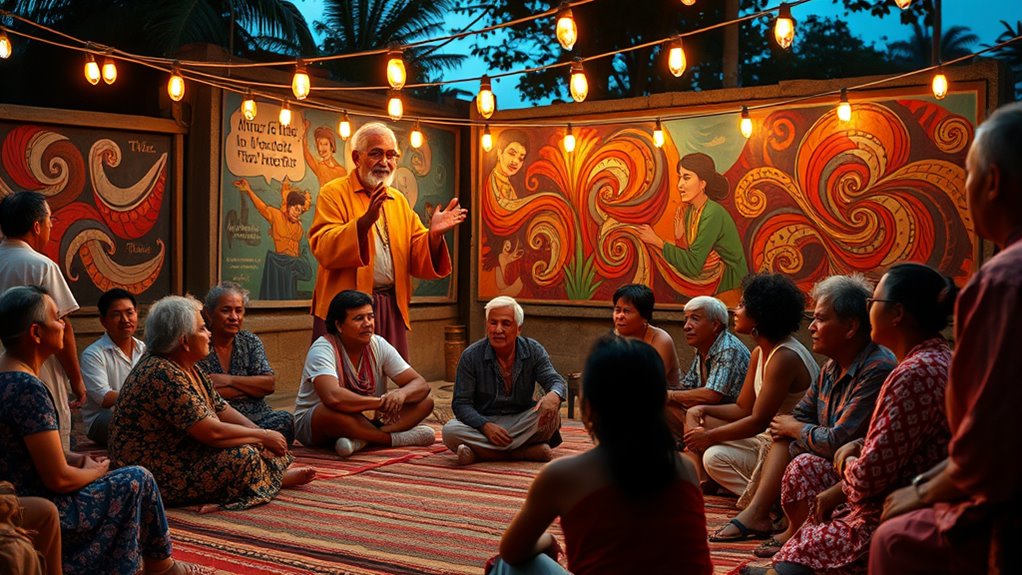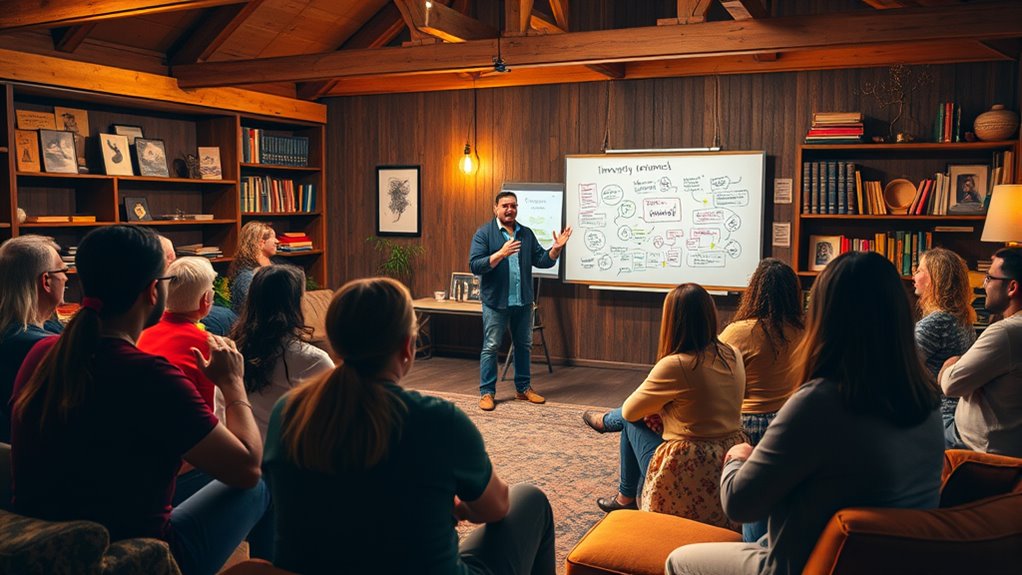To effectively spread innovative ideas through storytelling culture, focus on crafting narratives that resonate emotionally and culturally. Use storytelling techniques like strong characters, well-structured sequences, and sensory cues to create memorable experiences. Incorporate cultural elements to boost authenticity and engagement. Understanding diverse storytelling traditions helps tailor messages for different audiences. By mastering these methods, you’ll develop powerful stories that persuade and inspire, making your ideas more impactful. Continue exploring to open deeper ways to harness story’s full potential.
Key Takeaways
- Incorporate cultural storytelling traditions to make innovative ideas resonate authentically with diverse audiences.
- Use structured narratives with relatable characters and sensory elements to enhance emotional engagement.
- Tailor stories to cultural contexts, blending universal themes with local motifs for broader acceptance.
- Leverage evolving storytelling mediums, like digital media, to effectively spread innovative concepts across cultures.
- Craft compelling narratives that align with cultural values to persuade, motivate, and inspire action around new ideas.

Have you ever wondered why some stories stick with us longer than others? It’s often because of how they’re told—through effective narrative techniques that tap into our emotions and memories. When you craft a story, you’re not just sharing information; you’re creating an experience. The way you structure your narrative, the characters you develop, and the sequence of events all work together to make your message memorable. These narrative techniques help your story resonate on a deeper level, making it easier for others to connect with your ideas and remember them long after the story ends. Incorporating essential oils for storytelling can even enhance emotional storytelling by associating specific scents with memorable moments, thereby strengthening the impact of your narrative.
Effective storytelling creates memorable experiences that deeply connect and resonate long after sharing.
Your cultural influence plays a significant role in shaping how stories are received and understood. Every culture has its storytelling traditions—whether it’s oral storytelling, folklore, or modern media—that influence how narratives are constructed. When you incorporate elements from your cultural background, you add layers of meaning that can make your story more authentic and relatable. This cultural influence also guides your choice of narrative techniques, helping you decide whether to use humor, tragedy, or allegory to communicate your message effectively.
Understanding the power of storytelling culture allows you to tailor your narratives to different audiences. If you’re sharing an innovative idea with a community that values storytelling as a tradition, you might craft a story that reflects their cultural motifs, making your message more compelling. On the other hand, when addressing a global audience, blending universal themes with cultural nuances can help bridge gaps and foster understanding. Your awareness of cultural influence enhances your ability to design stories that not only inform but also inspire and motivate.
Moreover, storytelling culture isn’t static; it evolves as societies change. By studying how different cultures tell stories, you can adopt and adapt narrative techniques that fit your purpose. Whether you’re trying to persuade, entertain, or educate, recognizing the cultural context behind storytelling helps you craft more impactful narratives. When you use storytelling effectively, you’re not just sharing ideas—you’re creating a shared experience that can ignite innovation, foster collaboration, and influence behavior. Your stories become a powerful tool to spread new concepts, making complex ideas accessible and memorable.
In essence, mastering narrative techniques and understanding cultural influence empower you to craft stories that stick with people. They help your messages break through noise and leave a lasting impression. When you harness the rich traditions of storytelling culture, you’re not only sharing information—you’re shaping perceptions and inspiring action.
Frequently Asked Questions
How Do Cultural Differences Influence Storytelling Techniques?
Cultural differences shape storytelling techniques by influencing how you craft and share narratives. You should consider cultural nuances, like values, beliefs, and communication styles, which affect storytelling diversity. For example, some cultures favor indirect, metaphorical stories, while others prefer direct, factual accounts. By understanding these differences, you can adapt your storytelling approach to resonate better with diverse audiences, making your ideas more compelling and impactful across various cultural contexts.
What Are the Key Elements of an Effective Narrative?
You need storytelling techniques that grab attention instantly, like a lightning bolt striking through the sky. Effective narratives have a clear structure—beginning, middle, and end—that guide your audience smoothly. Use vivid characters, relatable conflicts, and emotional arcs to make your story unforgettable. When you master these key elements, your message becomes powerful and persuasive, making your ideas resonate and spread effortlessly across diverse audiences.
How Can Storytelling Foster Innovation in Organizations?
You can foster innovation in your organization through storytelling by leveraging visual storytelling to make ideas more compelling and memorable. Engaging narratives create emotional connections, inspiring your team to embrace new concepts and take risks. When you share stories that resonate emotionally, you motivate others to think creatively and collaborate, transforming innovative ideas into shared visions. This approach builds a culture where continuous innovation thrives through meaningful, visual, and emotionally engaging stories.
What Challenges Exist in Integrating Storytelling Into Corporate Culture?
Have you ever wondered if your corporate culture can truly embrace storytelling? Challenges include gaining employee engagement and ensuring leadership influence. You might struggle to get everyone on board or to maintain consistency in narratives. Without strong leadership influence, storytelling can feel superficial or disconnected. To overcome this, you need to foster open communication and demonstrate genuine commitment, making storytelling an integral part of your organization’s identity.
How Can Digital Media Enhance Storytelling for Idea Dissemination?
Digital media boosts your storytelling by making it more engaging through interactive visuals that capture attention and evoke emotions. You can easily share compelling narratives across social platforms, reaching a wider audience quickly. This approach encourages participation, feedback, and dialogue, helping you spread innovative ideas more effectively. By leveraging these tools, you turn stories into powerful catalysts for cultural change and innovation within your organization.
Conclusion
Just like Odysseus steering uncharted waters, you now hold the power of storytelling to chart new courses. Embrace your narratives to inspire, persuade, and ignite change. Remember, stories have always been the Trojan Horse, sneaking powerful ideas past defenses and into hearts. So, wield your words wisely—your stories can become the legends that shape tomorrow’s culture, turning ordinary moments into epic tales that resonate through time.









